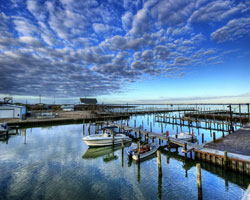Bacteria on the Beach
 traveldestinationinfo.com
traveldestinationinfo.comGrand Isle, Louisiana, was one of the tourist towns on the Gulf Coast hit hardest by last year’s BP oil spill. As oil began to surface on the beaches of Grand Isle, national media outlets swarmed the small barrier island. President Obama even visited the town twice to keep tabs on oil cleanup efforts. Amid the frenzy, Grand Isle businesses faced a serious economic blow, and tourism dropped by 80%.
Though Grand Isle’s beaches are now re-opened and reported to be free of oil, beachgoers are still advised to swim at their own risk due to high levels of bacteria in waters along the public beach and in the state park. Last week, Grand Isle Mayor David Camardelle reassured tourists that instances of bacteria in waters off the island’s coast have been a regular occurrence since he was a child. State officials test waters regularly and diligently post warnings on beaches, he added.
“We’re very concerned, and we’re on top of it,” he said.
But according to the Natural Resources Defense Council (NRDC), beach water bacteria is on the rise. Their annual survey Testing the Waters found that 2010 had 24,091 bacteria-caused beach closings—the second-highest level since the NRDC began tracking beach closings 21 years ago. The report also stated that in 2010, the source of contaminated beach water was reported as unknown more than half the time. Currently, the source of beach water bacteria in Grand Isle remains unknown, but environmental scientists have said much of the bacteria may come from the septic systems of businesses, camps and homes on the island.
Many beaches across the nation this summer are facing closures from unsafe levels of water bacteria. Florida has had extensive no-swimming advisories posted on beaches throughout the state, which has many concerned about the state’s Department of Health proposal to cut funding for testing beach water bacteria. The Florida Department of Health has proposed dropping 57 beaches from the state’s Healthy Beaches program.
Florida began monitoring bacteria levels at beaches in all of the state’s 34 coastal counties in 2000. In 2002, the Healthy Beaches program began taking weekly samples with an U.S Environmental Protection Agency (EPA) grant. If bacteria levels are high enough for water quality to be labeled poor, a follow-up sample is taken. If that sample also falls into the “poor” category, no-swimming advisories are posted at the beach until the bacteria readings return to safe levels.
The state argues that cutbacks are necessary after the Florida Department of Health cut $525,000 from its water quality testing budget, leaving only a $530,000 grant from the EPA to run the program. The health department has submitted the revised program to the EPA for approval, and changes could go into effect in September, state agency spokeswoman Christie Goss said. If Florida’s new program does go into effect, beaches still on the testing list would only be checked every other week. However, those tested will soon have to abide by stricter national water quality standards.
Next year, the EPA is legally obligated to issue updated beach water quality standards, which have been the same since 1986. According to the EPA, scientists have learned much about molecular biology, virology and analytical chemistry since 1986 and they are using this new information to help build a stronger scientific foundation for up-to-date recreational water quality criteria. Current EPA methods to determine water quality can take up to 36 hours for results, which means a decision to close a beach can occur after swimmers have been exposed to high levels of bacteria, which can lead to fever, diarrhea, vomiting and skin rashes. The agency hopes for to their new beach water criteria to allow greater use of the quantitative polymerase chain reaction (qPCR) water sampling method, which can produce bacteria and pathogen results in as few as three hours, in turn allowing scientists to quickly determine if there are organisms present in beach water that may be harmful to human health.

